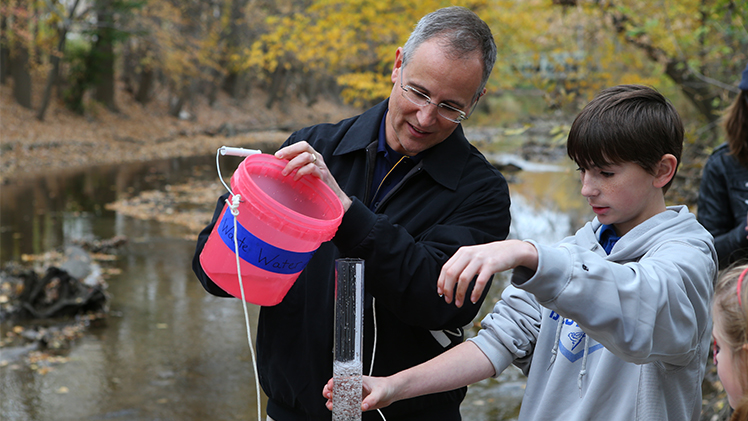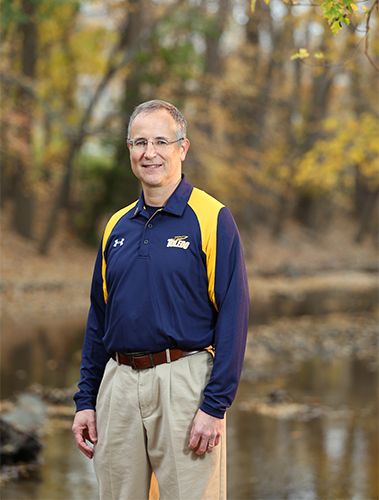From Ohio to the Netherlands and Saudi Arabia, middle school students are collecting scientific data and asking research questions critical to the study of urban heat islands and climate change thanks to a NASA-funded STEM project led by The University of Toledo.
Thousands of students in 6th, 7th and 8th grades across the U.S. and around the world upload their surface temperature measurements — asphalt, concrete, dirt and grass, in both sunlight and shade — to a database shared with climate scientists through NASA’s GLOBE program.

Since Dr. Kevin Czajkowski’s GLOBE Mission EARTH program began in 2015, the professor of geography and planning has expanded it to 42 countries with more than $24 million in NASA funding to transform how K-12 science is taught to thousands of students every year.
Participating schools and classrooms are trained and connected through the coordination of Dr. Kevin Czajkowski, professor of geography and planning in the UToledo College of Arts and Letters.
“Are the student observations accurate?” Czajkowski said. “The answer is yes. We use National Weather Service observations to compare. They’re gathering street-level information to supplement satellite readings and ultimately help local governments make important decisions about how to make their cities safer in a warming world.”
Since his GLOBE Mission EARTH project began in 2015, Czajkowski has been continuously expanding his work to transform how K-12 science is taught in the United States using more hands-on experiments and direct observations to solve environmental problems.
Nearly 10 years later, GLOBE Mission EARTH has gone international — expanding to 42 countries with more than $24 million in funding and partners including NASA Langley Research Center, Boston University, Tennessee State University, Palmyra Cove Research Facility and University of California at Berkeley.
“The purpose of the program is for students to do their own science and be engaged,” Czajkowski said. “They’re studying a topic in their own neighborhoods.”
Armed with digital infrared surface thermometers and air quality sensors, the students are learning why communities need to plant more trees, among other things, to help cool down their neighborhoods.
In October 2022 alone, more than 7,000 air temperature measurements were taken by hand by students in the Netherlands.
In 2021 Czajkowski participated remotely as students in the Mediterranean country of Malta, which is smaller than Ohio, gave presentations and a long list of recommendations to their Prime Minister regarding everything from marine pollution and loss of biodiversity to sustainable food consumption.
Five students at Gozo College Middle School in Malta wrote a report showing surface temperature on their school grounds varied on average by 9 degrees Celsius between grass-covered surfaces and cement or asphalt surfaces. They went one step further, however: Using toilet paper rolls and old newspapers, the students prepared nearly 500 seed packs to distribute to families to plant trees.
A student group in Greece made a video after investigating their playground, which is made of artificial turf.

Through Dr. Kevin Czajkowski’s program, thousands of students in 6th, 7th and 8th grades in the U.S. and worldwide upload their surface temperature measurements to a database shared with climate scientists through NASA’s funded GLOBE program.
“Artificial turf is one of the hottest surfaces,” Czajkowski said. “Hot playgrounds can be dangerous and make children sick. Plants can make a playground much cooler.”
Steve Oswanski, an animal science teacher at Toledo Public Schools, used the GLOBE program to help his students learn more about orangutans in another part of the world and how urban heat islands are encroaching upon the orangutan habitat.
“In a time of increasing teacher burnout, these moments renew me and give me hope that our efforts make a true difference in the world,” Oswanski said. “Learning skills is always important, but the opportunity to link communities and take action is truly life-changing.”
His class connected with an undergraduate student in Indonesia, who is focused on the dangers surrounding deforestation and poor agricultural practices.
“We were able to send the first Purple Air Sensor to her country,” Oswanski said. “Nikita Christy Alfeana’s work to deploy and maintain this technology adds data that can help understand the effects of slash-and-burn agriculture on its community’s quality of air and life.”
In the U.S. alone, approximately 5,000 K-12 students participate in the GLOBE Mission EARTH project each year at about 50 schools.
Czajkowski has used the student data to publish research in scientific journals. One example is the impact of the 2017 solar eclipse on the weather in the U.S.
“We showed the temperature dropped from the eclipse, and we’re working on another paper about the changes in cloud cover,” Czajkowski said. “With lack of solar heating the clouds dissipate, so you can see the solar eclipse better.”
His team is gearing up for the 2024 solar eclipse. Next year’s curriculum for participating teachers will be focused on the solar eclipse and urban heat islands.
“The interesting thing is, the instruments and observation techniques used to study urban heat islands are the same ones to study weather and the impacts from a solar eclipse,” Czajkowski said. “All of us, from middle school students to professional scientists, will be ready to start our research.”